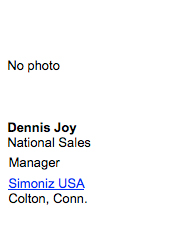Contributors:
 |
 |
 |
 |
1. When choosing hand soaps, what is the difference between antibacterial and antimicrobial?
Dennis Joy: The janitorial market tends to use antibacterial and antimicrobial hand-soaps interchangeably.
Richard Schmidt: Practically speaking there is no difference. Even the U.S. Food and Drug Administration uses these terms interchangeably. Literally there would be a difference. Antibacterial would be active against bacteria only. Antimicrobial would be active against microorganisms in general, e.g., bacteria, viruses, yeasts, etc.?
Yon Makino: While there isn't a consistent industry standard for distinguishing between antibacterial and antimicrobial hand soaps, at Henkel we view the term antimicrobial to be more encompassing than antibacterial.
Antibacterial soaps by definition have bacteria-killing properties, whereas antimicrobial soaps kill microbes, which include not only bacteria but also yeast and/or molds. It could also include viruses, but the U.S. Food & Drug Administration has different guidelines around anti-viral claims, requiring the same multimillion dollar five year plus process of a New Drug Application (NDA) that a pharmaceutical drug would undergo. Thus, most reputable suppliers will not make anti-viral claims on their hand soaps or sanitizers.
If you seek the broader protection of an antimicrobial soap, you should ask your supplier if their product has been tested on organisms beyond bacteria.
Jim Prestage: Antibacterial soap kills bacteria. Antimicrobial, a term generally only used in healthcare, refers to the ability to kill bacteria, virus, yeast, fungi, etc. Both antibacterial and antimicrobial soaps kill bacteria and promote effective hand hygiene. There is no requirement for antimicrobial soaps in healthcare settings.
2. LEED-certified facilities don't allow anti-microbial soaps. Is there a greater likelihood of building occupants spreading disease in these facilities?
Makino: I think that possibility needs to be considered. Certainly the most important hygiene action to take is to simply wash your hands. However, beyond that, our research department has published several papers showing that under like washing conditions, the quality of the soap can make a big difference in not only the amount of disease-causing germs remaining on your hands after washing, but also the number of germs that were then transferred to another hand or object that was touched. In one study comparing antimicrobial soap to an ordinary soap, the data suggested that washing with antimicrobial soap could help reduce transmission of disease by 50 percent compared to washing with an ordinary soap ("Reduction of Bacteria from Hands to Food," Journal of Food Protection, Vol. 70, 2007).
Schmidt: According to the U.S. Centers for Disease Control and Prevention (CDC), the single most important way to prevent the transmission of diseases is to frequently wash your hands with soap and water. Practicing proper hand hygiene (which includes using cleanser and tepid water, utilizing adequate friction, washing for at least 20 seconds, rinsing thoroughly and drying with paper toweling or approved air drying device) is the important factor in keeping building occupants healthy. It is vital to educate workers about the importance of hand hygiene and to inform them that participation can help prevent sickness, expensive visits to a physician and lost work time.
Joy: Part of the whole process of reducing bacteria and viruses is by basic hand washing and through cleaning. By following these practices the spread of disease is greatly reduced.
3. Is foam hand soap more cost-effective than liquid soap? What about for hand sanitizers: is foam more cost effective than gel?
Makino: Foaming hand soaps definitely have the potential to be more cost-effective than liquid soaps. Because the visual cue on your hands is that of a high-volume foam vs. a low-volume liquid, it tends to trigger an earlier "enough" response. Then when the patron spreads the foam on their hands, as long as the amount of foam provides adequate hand coverage, it will be a satisfying experience.
With liquids, more tends to be applied, often with some portion falling into the sink while lathering, creating a wasteful situation. Contrast this to foaming soaps that tend to cling better to the hands. Additionally, some foaming soaps can save water, both by not requiring prewetting of the hands prior to dispensing soap and requiring less rinsing if the soap washes off quickly.
With hand sanitizers, the clear benefit of the foam over the gel is the foam clinging better to the hands, reducing the amount of drip or slinging while rubbing. Since alcohol tends to discolor carpet, walls, or clothing, and removes wax from floors, keeping the alcohol on the hands until it evaporates is desirable.
Whether you can use less with a high volume foam vs. a gel depends. To achieve a high level of germ kill, enough foam or gel must be applied to the hands to keep them wet for at least 15 seconds. A thumbnail-sized dollop of gel can provide far more alcohol contact time on the hands than the equivalent size of an aerosol mousse foam. The latter, being mostly air, would need almost a baseball-sized dollop to achieve the same wetness contact time. A nonaerosolized foaming hand sanitizer would seem to be an effective compromise then, offering the benefit of clinging to the hands while not requiring a large volume to keep the hands wet.
Joy: Foam tends to be less expensive. However, many factors come into play such as product pricing, manufacturer, and type of dispensing units; such as whether it's mechanical or touch free.
Prestage: Total in-use hand hygiene costs are impacted by many things, including number of actuations of the dispenser, and water and paper towel usage. Considering only the cost of the soap/sanitizer product, the cost per hand hygiene event differs by user. Foam is generally less expensive per hand hygiene event — but if a user hits the push bar twice with foam, but only once for liquid or gel, then liquid might cost less. Since the goal of hand hygiene is maximum employee productivity by reducing the spread of germs that can lead to absenteeism and illness, customers should pick the hand hygiene format and brand that their users prefer and will use. The key is getting people to practice hand hygiene when they should. If hand hygiene is done effectively, the product will pay for itself — regardless of format.
Schmidt: One is by no means more cost-effective than the other. It all depends on how much the end-user applies. There is anecdotal evidence to show that end-users of foam products may end up using as much as liquid end-users. This could be because foam products often dispense far less than 1 milliliter of product and the end-user feels the need to pump multiple times in order to get an adequate level of surfactant on the hands. However there is also anecdotal evidence to show the opposite is true.
At the end of the day, what is important is to use enough product to get the job done. In the case of hand sanitizers, one should use enough to completely wet all surfaces of the hands, fingers and nails for at least 15 seconds. One study conducted at the University of North Carolina at Chapel Hill showed that using an alcohol-based hand sanitizer for only 10 seconds reduced bacteria levels no more than rinsing hands with plain water.
4. Frequent hand washing can dry out skin, especially during winter months. What kind of soap and hand sanitizer products can be used to ensure patrons don't decrease hand washing?
Schmidt: To help reduce skin irritation from hand washing, handwash products can be formulated with surfactants that have a relatively low potential for irritation. Examples of such relatively mild surfactants would be betain derivatives, sodium laureth sulfate, so-called "sugar-surfactants," and sulfosuccinates. One particular surfactant, which is very widely used in the United States, sodium lauryl sulfate, should be avoided at all costs as it is very irritating to the skin. Handwashes can also be formulated with emollients or re-fatting agents, which help to leave some oil on the skin and compensate for the oil, which was removed by the surfactant.
Alcohol based hand sanitizers are not as drying to the skin as once thought. Studies show that these products are less irritating to the skin than soap and water because they do not emulsify the natural oil on the skin and get rinsed away. Caution should be used about using formulations with "emollients" because they can lead to a build up of residue on the skin and often leave a tacky afterfeel. One alternative is to formulate with a humectant, which can leave the skin feeling soft and smooth without the tacky afterfeel or residue build up.
Makino: High quality soap and sanitizer products should contain skin conditioning agents that help to moisturize, retain moisture, and keep hands feeling soft and smooth after using. Ideally, they should also be dermatologist-tested for hypoallergenicity. For hand-washing products, the selection of a mild surfactant over an aggressive one helps to reduce irritation.
The soap or sanitizer product you are considering may have undergone several skin study tests, such as cumulative irritation or repeated washing tests — the latter from which transepidermal water loss and redness/dryness/tightness assessments can be made — to compare its mildness to well-accepted market formulas. It doesn't hurt to ask the manufacturer of the soap or sanitizer you are considering if they have any data like this.
Finally, feel free to trial the product of interest in pump bottles before hanging dispensers.
Joy: Quat-based hand sanitizers generally have a better feel and are less drying than alcohol-based ones. Frequent use of alcohol based sanitizers cause dry skin, which discourages use. Antimicrobial hand soaps that contain emollients ad moisturizers will have a less drying effect than those that do not.
Prestage: Good hand soaps and hand sanitizers — particularly in healthcare settings — must be effective in killing germs, but mild on the skin. Workers in office environments don't practice hand hygiene nearly as frequently as healthcare workers (HCW). While recognizing the potential of some hand sanitizers to dry out skin when used repeatedly, the U.S. Centers for Disease Control and Prevention (CDC) pointed out that "...several studies have demonstrated that alcohol-based hand rubs containing emollients are acceptable to HCWs." Hand cleaning products with emollients and skin conditioning agents help maintain the skin's normal barrier foundation to retain moisture.
5. What are the pros and cons of the different types of hand sanitizer: gel, foam and spray?
Prestage: All three formulations have the same efficacy, or germ-killing ability. Gels are easy to apply and provide excellent coverage. Many users prefer the texture and feel of gel, which can lead to increased compliance. Foam hand sanitizers cling well to the skin, offer minimal drip, and are considered aesthetically pleasing to many in the nursing profession, especially in North America. The key advantage of spray formulation is its mobility and convenience. Healthcare workers and other users can carry spray hand sanitizers on their belts for instant access whenever needed.
Schmidt: Gel sanitizers provide excellent portability, ease of use, and customer acceptance. On the flip side of the coin, alcohol has that "clinical" odor some people consider a negative factor. Foam and spray sanitizers are easier to use in a less "on the go" scenario since both products liquefy quickly and can drip readily. Both foam and spray can also have a sticky after-feel on the hands for several minutes.
Makino: As long as the hand sanitizer is alcohol-based containing 60 to 95 percent alcohol, and sufficient quantity is applied to the hands to keep them wet for at least 15 seconds, all forms are potentially effective. I would recommend that any hand sanitizer contain skin conditioners to protect the skin from the possible drying effects of alcohol. If a gel is too runny, it tends to drip onto the floor, suggesting that a more viscous gel may be desired. Foams are often preferred because they tend to cling better to the hands, but caution must be paid — particularly with aerosolized foams — to using a sufficient volume to meet the 15 second wet hands criteria. Sprays are convenient, but once again one must be cognizant of applying a sufficient volume for a minimum of 15 seconds wet time. Ultimately the form chosen should meet the needs of both the building services contractor and user preference.
6. When H1N1 hit, building service contractors had a difficult time securing enough hand sanitizer. What actions do you recommend BSCs take to ensure supply during a pandemic?
Schmidt: Should we encounter another pandemic, manufacturers of sanitizers will most likely experience the same difficulties as during the H1N1 outbreak: overwhelming demand outpacing availability of raw materials to manufacture product. A BSC might negotiate a contract now for priority delivery of sanitizer with their supplier, who in turn could do the same with a manufacturer.
More importantly, be proactive now. Every business has its own system for setting stock levels and adjusting inventory according to seasonal demands. Seasonal flu peaks around February and cases can extend into May. This happens annually, and we encourage BSCs to include hand sanitizers in their "critical products" inventory in order to be able to respond readily to customer demands for hand sanitizer.
Makino: H1N1 created an unusual situation that was difficult to predict. We were fortunate it didn't achieve the epidemic proportions many feared, and certainly vaccinations and increased focus on hand washing and sanitizing helped.
BSCs might consider adjusting their buying patterns somewhat to match normal flu season cycles, but I don't think it would be financially prudent to stockpile hand sanitizer. The good news is that manufacturers who experienced the skyrocketing demand during H1N1 season, should be better prepared to handle supply issues next time.
Prestage: The best way for BSCs to help customers prepare for higher levels of influenza activity is to ensure hand hygiene is embedded as an everyday behavior. If hand hygiene is practiced regularly — even outside of pandemic situations — customers will be prepared for anything through normal inventory levels. Problems occur when customers must rush to install dispensers and buy inventory at a time when everyone else is doing the same. If alcohol-based hand sanitizer is regularly available at restroom exits, on desktop and in lunchrooms, break rooms, lobbies and other public spaces, you'll always be prepared.

 Celebrating BSCAI's 60th Anniversary eBook
Celebrating BSCAI's 60th Anniversary eBook The Down and Dirty on Cleaning in Virus Season
The Down and Dirty on Cleaning in Virus Season How Surfactant Use is Expanding in Commercial Cleaning
How Surfactant Use is Expanding in Commercial Cleaning